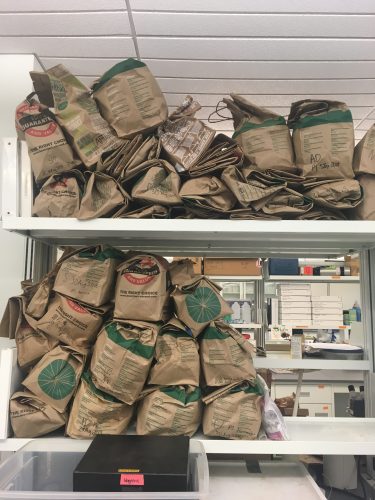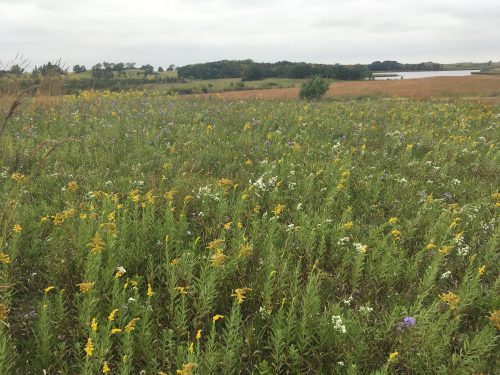This week the Echinacea Project welcomes our three Lake Forest College interns: Emma, Leah, and Emily! We’re excited to have them for the next four weeks helping out in the lab. Emily is pinning bees from Hegg NE for Kristen, Emma is looking at our 2015-2017 heads in the aphid addition and exclusion experiment, and Leah is looking at our 2015-2017 heads in the pollen limitation experiment. Look forward to more updates from Emma, Leah, and Emily themselves!
|
||||
|
Hello from Chicago! All members of team Echinacea have evacuated Solem Township for the season and migrated to warmer climates (well except for those who stayed in Minnesota). No worries though, we’ll be back soon to harvest the last 21 heads that just weren’t quite ready when we left. Once we have those heads, it will be time to start recording new data! Back at CBG, we’re getting underway with processing the data that we collected this year. The first step, as always, will be inventorying the heads that we collected in the field this year. How many heads you might ask? This many: We’ve definitely got our work cut out for us, but it’s nothing that we can’t handle! Be on the lookout for our yearly project updates, they will start being published soon. Thanks for reading! Hello, Flog! The field season in Minnesota has wrapped up, and we have all returned to continue working hard at our various institutions. For the members of this years team returning to the Chicago Botanic Garden, that means analyzing all of the data (including 1000+ Echinacea heads) that we collected in the field and in our experimental plots. Our last few days at the Hjelm house have been filled with harvest and management, getting ready for our prescribed burns this fall and spring. We’ve harvested all sorts of species – everything from Asclepias to Viola – in preparation to spread them after the burns in p1 and p8. Thanks for reading the flog this summer! Here’s a parting shot of Hegg lake from the last day we were out there: white and purple asters with some great Solidago!
Hello, Flog! Monday was, unfortunately, a rainy, rainy day. Well, okay, maybe it started out just a slightly rainy day. But the kind of rain that makes it just impossible to do any dampness-sensitive research. We started off the day with the usual moist trudges through the ever-present big bluestem, and even managed to complete a few of the many field rechecks we have to do. What are field rechecks you might ask? Sometimes, we look over the data from a summer and go, “Huh? What? How did this happen?” Our data, frankly, just doesn’t make sense. Sometimes one person will look at an area and say “There’s one plant!” and another might say “There are six plants here!” When we look at this data later, we need another opinion as to how many plants are there. And in comes field checks! (They’re particularly easy to do because they require the least walking, and therefore the least wetness.”) Now, after lunch, picture Michael, Andy, and Lea poised to do P2 harvesting. Imagine them with bags and clippers in hand, ready to save achenes from the cruel fate of the ground. Imagine the cars bursting with egg cartons and data sheets full of LetNos (the identifiers we use each head). Now imagine rain. You’re not imagining enough rain, imagine more! Well, it rained enough to make harvesting impossible. So instead of experiencing the thrill of saving a head from dropping achenes, we did some coding in R and called it a day. Here’s to less rain this week! Michael Hello, flog! Today, Team Echinacea continued our quest to measure every plant in P1. Yes, it takes a long time and yes, the big bluestem might be over our heads, but we will always carry on! A quick recap of today’s measuring events: After completing half of “Big Batch,” yesterday,(Big Batch is a large group of plants at the south end of the plot), we attempted to push ourselves to finish the rest of the plot today. And by “we” I mean two teams, in particular, decided to finish their rows as fast as possible (these teams will remain unnamed and totally not depicted in the pictures below). 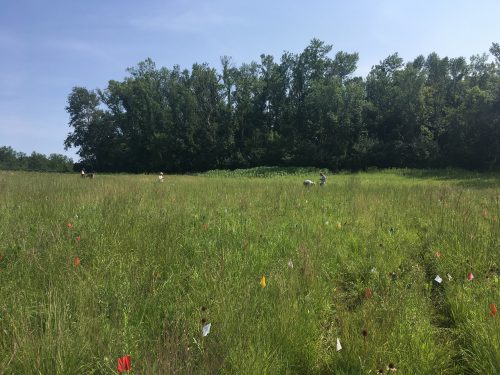 Some A+ measuring These teams finished their rows impressively fast, and, while we made a good dent in the remaining measuring locations, we did not end up finishing. In the spirit of competition, I have decided to rank the participating parties in how good they were at measuring. The results can be seen below.  Rank #1: All humans who participated in the measuring today. Some humans are not pictured here but they were also just as good
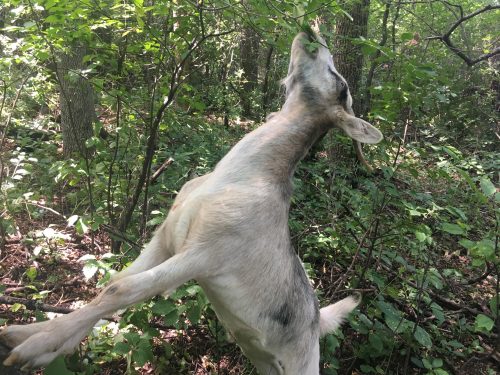 Rank #2: The goats. They’re good at removing buckthorn but not great at measuring echinacea Thanks for reading! Happy Saturday, Flog! Seeing as it is the weekend, I, unfortunately, do not have any pictures of us hard at work in the field (you’ll have to ask team CoW Bee for those). What I do have, however, are screenshots of my contribution to the project today. While, undoubtedly, my favorite part of being on the Echinacea team is the awesome field work we get to do, I can’t deny what cool things one can do with a computer as well. For the past week, I have been getting back into the groove of using R, the statistical coding software that we use for analysis of the data we collect in the field. This weekend I was given the simple task of drawing a polygon, in R, around some of our points. Easy, right?  The points in question (then some extras) So first I isolated the points in question.  So far so good! Then, I wrote the command in R to draw a polygon around these points. And with an extra line of code, I even added a 5-meter buffer around the whole shape. With this polygon drawn, we can now very quickly isolate these points (which all happen to be Echinacea pallida), and do further analysis on them, and any other plants we may find in the polygon area in the future! So without further ado, I present, the polygon! 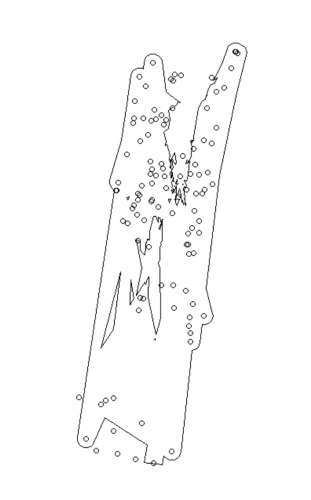 Whoops At some point soon I know I’ll be able to figure out how to draw the polygon around these points, but for now it’s back to the drawing board (or coding board). Thanks for reading! Michael Hello, Flog! Today Team Echinacea tackled our third Big Event, “Big Event 3: Return of the Bees” (or “Big Event 2: Electric Boogaloo 2: Electric Boogaloo” for those who are more “systematic” as Will puts it). It was a hot and early morning, but the pollinators were out, so we were too! I worked with Riley in this event, and while I can’t speak for everyone, I can say we saw a fairly large number of correct bee visits; when we weren’t jumping to shoo away bees from plant 24-37 (which had over 200 anthers shedding pollen during the event). Once temperatures hit over 90 degrees around 10:30, the team decided that it would be a good idea to head inside for a break. Just kidding. Once the temperatures hit 90 degrees around 10:30, the team split up into task forces to accomplish the remaining goals for the morning. I went to move tents for Kristen’s project (no 100% confirmed capture of any bees yesterday, but there might have been one). Other task forces tackled Staffanson and P1 phenology, working through the scorcher like it didn’t even phase them. During lunch, we had an… enlightening discussion about what constitutes a sandwich, with each team member weighing in on that age-old question: “is a hot dog a sandwich?” A few came down firmly on one side or the other, with Andy saying, “no, a hot dog is not a sandwich because if you asked for a sandwich and someone gave you a hot dog you would be surprised,” and Riley saying that hot dogs, tacos, burritos, and even pie constitute a sandwich. It was predictably heated. After lunch, the clouds rolled in and the wind picked up, leading to a much cooler afternoon, much to the relief of the whole team. While the measuring of plants in P7 wasn’t quite as successful as we hoped it would be, we did manage to locate a source of aphids near Hegg lake, as well as mark the location of most flowering, non-native E. pallida in the area. Also, my day was brightened by this lovely butterfly milkweed, of which this is the only plant I’ve seen this year.
 Butterfly Milkweed (I think) Get ready soon for Big Event 4: Revenge of the bees! (Or Big Event 2: Electric Boogaloo 2: Electric Boogaloo 2: Electric Boogaloo) Michael
Today, Team Echinacea took a significant detour from our normal routine. Not only did we leave Solem Township on an adventure to Glacial Ridge National Wildlife Refuge, but we didn’t even study Echinacea while we were there. No, instead we studied a member of the orchid family, the endangered western prairie fringed orchid. Our trip north started early in the morning, with us leaving the comforts of Alexandria at 6:00 AM, in order to arrive at the site by 9:00 AM. Of course, a much-needed donut stop was had along the way. Once we arrived in the first of the two experimental sites, we got to work finding the prairie orchids.
We do a full census of the prairie orchids that are on the experimental plots, which means we need to find every orchid that is within the boundaries of the study. And therein lies the challenge. The plants themselves aren’t necessarily too hard to find: big ostentations flowers, often with 5+ flowers on a plant. No, what is challenging is figuring out where one is within the experimental plots. The corner of every 10 meter by 10-meter plot is marked with a short wooden post, which, in tall grass and ankle height waters, at times, can be quite difficult to find. Of course, we learned to use our extreme geometry skills to locate the locations of where posts should be (as some posts simply weren’t there).
All things considered, Team Echinacea had a very successful day as Team Orchid (or Team Platanthera, if you prefer). we found 584 plants within the experimental plots and got to see many new plants and birds that are not present in our Echinacea plots, like the showy milkweed and the upland sandpiper. Get ready for tomorrow to hear all about the Big Event! Michael
Echinacea Project 2018 Biology and Environmental Studies, Tufts University 2018 Research Interests I have been interested in plants since I was old enough to explore the woods in my backyard. Since then, I have done research on plants throughout my college career everywhere from Costa Rica to Iceland and found myself incredibly intrigued by how changing landscapes affect ecosystem dynamics, particularly plant-insect interactions. I have never before been a part of a research project that has been as long-term as the Echinacea Project, nor have I ever been to the long grass prairie, let alone researched it. Statement I grew up in Sudbury, Massachusetts about 20 miles west of Boston, and just graduated to Tufts University about a month ago. In my free time, I enjoy running, hiking, reading, or just about any activity that involves being outdoors. I hope in the future to make field biology my career, and am very excited to join Team Echinacea!
|
||||
|
© 2024 The Echinacea Project - All Rights Reserved - Log in Powered by WordPress & Atahualpa |
||||



